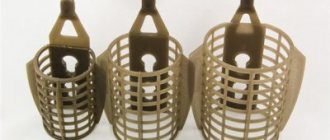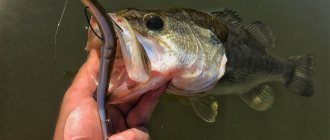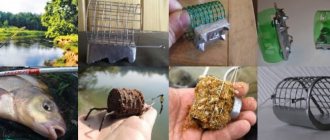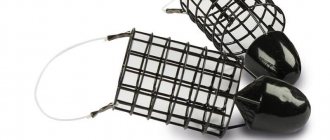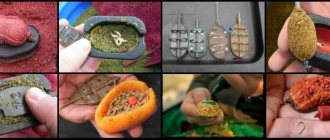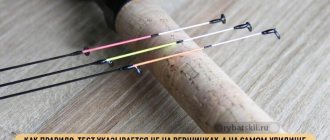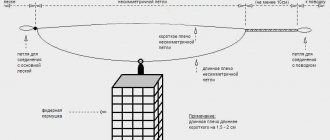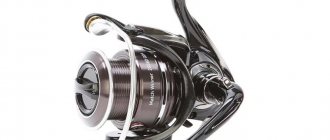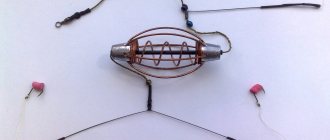The main task of the feeder feeder is to deliver a portion of bait to the point and return it when the tackle is reeled out. Feeder equipment, tactics - tools that are used to feed the point. The feeder for feeder fishing is the basis of installation, the main element of the equipment. Feeder equipment options are selected depending on fishing conditions, characteristics of the reservoir and fish behavior. To solve feeder problems, feed devices of various configurations are used. Let's consider which feeder to choose for the feeder in various reservoir conditions, equipment and type of fish.
Feeder in feeder equipment
The following factors influence the use of feeder feeders:
- Distance to point.
- The weather, or rather the wind.
- Depth and current.
- Specific fishing tasks by type of fish, characteristics of the consistency and composition of bait, tactics.
- Installation and equipment of feeder gear.
Feeder fishing can be divided into two large subdirections. This is classic feeder and method fishing. In the first case, standard feeder installations are used, with the usual method of attachment to the equipment. The second direction is the flat feeder method, where the equipment is performed according to the inline principle. More information about feeder installations:
In each direction, different types of feeder feeders can be used - according to configuration, weight, feed capacity and other characteristics. A feeder's kit requires different types of feeders - this will allow you to customize the tackle to suit any conditions.
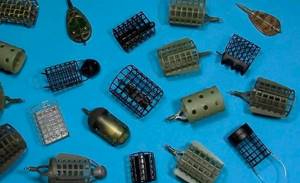
Application of feeders
From the shore
When fishing from the shore, there are two main ways to use feeders:
- Fishing with a float rod and retrieving. A safety cord will need to be attached to the feeder to move it and remove it from the water. Additionally, a fishing line with a float is attached, which allows you to determine the location of the device in the reservoir after casting.
- Fishing with bottom tackle with constant casting of the feeder in one place, this will require not making too much effort and choosing a landmark located on the opposite side of the shore.
From the boat
Instructions for using the feeder while fishing from a boat are given below:
- The boat is turned so that it faces the direction of the current, after which the anchor is lowered.
- Select suitable tackle - donka or feeder; When fishing in weak currents, you can use a regular float rod.
- Additionally, it is recommended to equip the fishing rod with a side nod about 20 cm long, which will make it easier to fix bites.
- It is recommended to use one tackle, since with proper complementary feeding, active biting should soon begin and it will be difficult to cope with a large number of fishing rods.
Options
Before we begin to describe specific models, you need to understand the parameters of the feed devices that the feeder must be able to operate. The classification is carried out not only according to the types of feeder feeders. In each type, feeding devices differ in:
- Weight.
- Size, or rather, feed capacity.
- The shape of the feed net or retaining ribs (for flats).
- Flight characteristics, feeder casting range.
- For still water or current.
- Method of attachment to equipment.
- Additional elements – stabilizers, bottoms.
- Composition and consistency of feeder bait mixture.
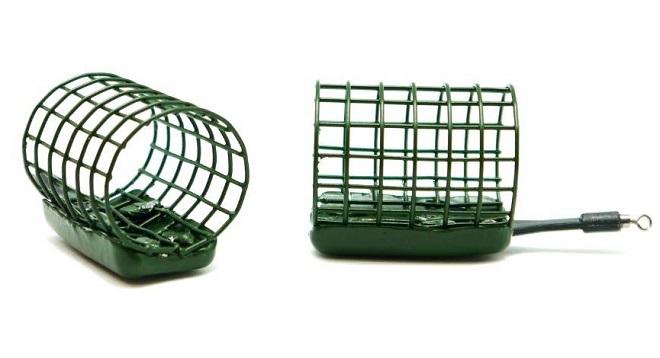
The most important part of feeder fishing is bait, its composition and consistency. All feeder tactics, equipment and installation pursue one goal - to deliver feed exactly to a specific place. The composition of the bait, its consistency and the equipment used are selected depending on the conditions. An article about bait for the feeder.
The feed capacity is selected based on tactics, depending on the conditions, the season and the required volume of bait associated with these moments and the frequency of feeder casting. The more feed you need, the more often we refill, and the larger the feed capacity is needed.
The weight depends on the test of the feeder rod, which is selected according to the required distance. The final selection of the weight of the feeding device is carried out after measuring the bottom and choosing a fishing point. You need to choose a feeder that will allow you to comfortably and accurately throw the feeder to the desired point, and accurately and often. The main difference between a feeder and a donkey in technology is frequent recasts to the same place, constant feeding of the point, especially in the current.

Let's take a closer look at which feeder is best to place on the feeder according to the parameters depending on the fishing conditions. There are no better feeds. You need to choose a form and model according to the specific requirements of feeder fishing tactics, and do it thoughtfully. This approach makes the feeder a thin and precise bottom fishing tool and allows you to fish when coarse gear is silent.
There are many different types of feeder feeders. However, the angler does not need all these hundreds of options. You need to develop your own system - put together your own set for the conditions in which most feeder fishing takes place. There is no need to collect excess - otherwise it will lie uselessly in drawers and take up space.
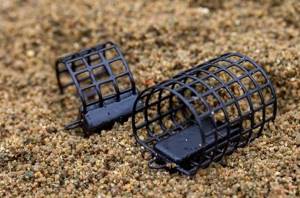
Weight
All feeder feeders differ in weight. The choice of weight is determined by:
- Casting distance.
- Depth and strength of the current.
The distance to the point is also determined by the test of the feeder rod. Picker rods with weights up to 60 grams are suitable for coastal fishing. The most common option is the average feeder, medium. Typically these are fishing rods 3-3.9 meters long with weights up to 90 grams. They allow you to comfortably operate weights up to 80 grams. For long-distance fishing on rivers with currents, large ponds and reservoirs, you need Heavy and Extra Heavy class feeders, with a length of 3.9 meters and a weight of 90 grams or more.
The greatest casting distance can be achieved with a weight that, together with the hammered mixture, is approximately 70-80% of the rod test. Feeder rods are designed to allow you to exceed the test and use heavier weights. It is recommended to do this only for experienced bottom fishers with advanced feeder casting techniques, otherwise you can simply break the rod.
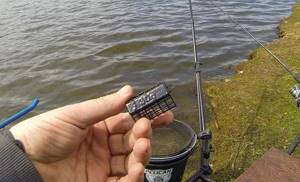
The second factor is current. In strong currents, you need heavy corks that can hold on to it. To cast them, higher test feeder poles are required. In addition to the test of the rod, the selection of weight is influenced by the diameter of the main line, the size and shape of the feed. On thin braid, the flow pressure on the line is less, and you can use lighter feeders. Small, heavy feeds are better held at the bottom than bulky, light ones.
For picker fishing and short casts in reservoirs with weak currents, you will need feed weighing up to 40 grams. Medium distances, gentle current – 30-60 grams. Long distances on the current – 80 grams or more. On a strong flow, you may need feeders weighing 100-120 grams or even more.
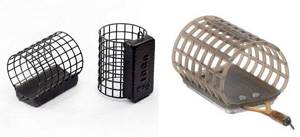
Optimal shape for flow
Feed capacity
The feeder needs to operate with the concept of feed capacity. A capacious cage holds more bait than a small one. Feed capacity depends on the relationship between the amount of bait, the frequency of casting and the strength of the current. In summer, more bait is required, in cold water - less. If we cast often, the amount of feed sent to the point increases, since each time the feeder is re-cast, the net is filled again. Therefore, in a fisherman’s kit, you need to collect several types of feeder feeders based on weight and feed capacity (read: cage volume).
When fishing, you may need to increase or decrease the amount of food you feed. This can be done by changing the frequency of re-casting or feeding capacity, placing the same weight in a larger or smaller cage volume. In a current, the strength of the flow must also be taken into account. In a strong current, a small feeder, for example, can stay well on the bottom. But if you place a larger one of the same weight, it may begin to demolish. In this case, you will need not just a larger cell, but also a heavier one.
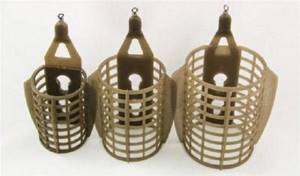
In stagnant reservoirs in shallow water - for example, when fishing for crucian carp or carp, you should not splash the water often; casts are made less frequently. However, in this case, a sufficient amount of bait must reach the point. This is where voluminous and relatively light (we select the weight according to the required casting distance) feeders will come in handy. They flop less due to their mass, and they deliver enough feed to the point. The feeder needs to constantly operate with the concepts of weight and feed capacity. Feeders of any feed capacity can be either heavy or light.
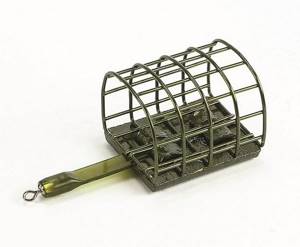
For current and still water
In the fishing community, a myth is constantly being circulated that round feeder feeders work worse in the current, as they roll along the bottom. This is not true, lifting surveys show that the feeders do not roll. They are lifted and tightened by a loop of the main line inflated by the current. Some manufacturers equip their feeders with spikes, antennae, and lugs, which increases the price. But this is a marketing ploy. To keep it at the bottom, we simply increase the weight of the feeder. Metal nets hold better than plastic ones, but they are more difficult to wear out and float up from under the edge.
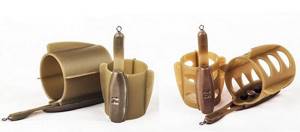
In strong currents, we use a thin braided cord with a shock leader for the base. In strong flows, we use cage designs with a flatter bottom, with oval-shaped meshes, flattened towards the sinker. With the correct selection of weight (after measuring the bottom), neither the feeder with a round cross-section nor the one with a square cross-section will be pulled off. Sometimes in stores you can see feeder feeders with a triangular cross-section, like they sit better on the bottom. This is a trick - such forms do not have any advantages, on the contrary - the feed capacity is less.
In the feeder, when it comes to feeders, there is no need to reinvent the wheel by buying a variety of designs. It is better to collect identical models, differing in weight and shape. The simpler the better. Therefore, the basis of the feeder set is ordinary metal or plastic meshes of different sizes and weights.
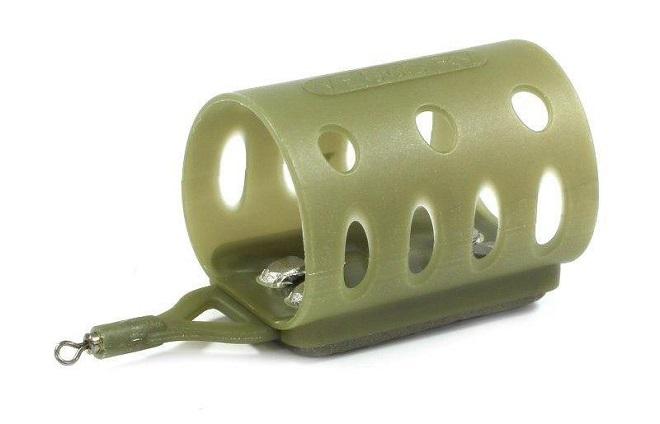
Washing out feed
In different conditions, it is necessary to regulate the rate of feed leaching. This can be adjusted by the consistency of the bait - make a more or less sticky mixture. The rate at which food is washed out also depends on the design of the cage. The food is washed out most quickly from metal nets, and slowest from plastic ones. For tempo fishing, when casts are made every 3-5 minutes, ordinary metal meshes are suitable. If you need the food to be washed out more slowly (with rarer re-casts), we install plastic feeders of a semi-closed type - with solid walls with holes.
The approach as in donks (filled with plasticine or a cube of hard cake so that it does not wash out) does not work in the feeder. On the contrary, in the feeder it is necessary for the feed to be washed out and create a stain (a trace on the current). When unwinding the tackle, you need to get a clean feeder. All bait should remain in the point. Therefore, the bottom is not used in feeder feeders; it is simply removed (if present).
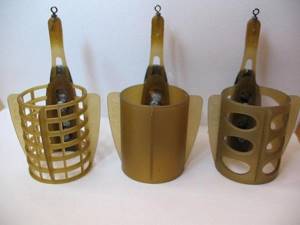
Even completely closed feeder feeders, with solid walls - without a bottom, so that when you take them out, all the remains of the bait spill out. The British have an interesting design - the ShotGun feeder, in which the mixture, after casting, is pushed out by a piston. I have not yet seen such a device in our stores.
Plastic or metal
As already mentioned, feeder feeders can be made of plastic mesh or metal. Plastic feeder feeders fly worse - for this purpose, stabilizer blades are installed on some of them. Stabilizers increase the accuracy of casting over long distances, however, they also have a drawback. In the current, plastic nets with wings float and are carried away more strongly, which is inconvenient at great depths.
The kit requires both plastic and metal mesh. Metal is more suitable for deep-sea fishing in currents. Plastic – fishing in shallow water, medium-strong currents, and also from under the edge, since plastic feeders float up better. You need to watch out for corrosion on metal meshes - you can’t fish if the feed is rusting, the fish don’t like the smell of iron oxide. Plastic kormacs are not subject to corrosion and rust, however, they are more fragile.

When fishing in shallow water, especially in clear water for cautious fish in spring or autumn, you need to take into account the camouflage properties. Black color on a light bottom or shiny metal can scare away fish. Plastic nets are painted in protective green or olive color. Transparent chameleon feeders, which conceal the outlines of the structure in the water, are useful in such conditions. Camouflage is a secondary characteristic, and it is worth paying attention to it once you have figured out the weight, food capacity and stability at the bottom.
You should assemble a set of feeders based on your own interests. We fish in rivers on the current - the main set is made of metal nets. Most fishing trips are on ponds, reservoirs and weak currents - it is more convenient to use plastic nets, and buy metal ones in small quantities, as a reserve for going to a current or a large river. This factor is subjective and individual. Some people simply prefer to use metal, others prefer plastic.
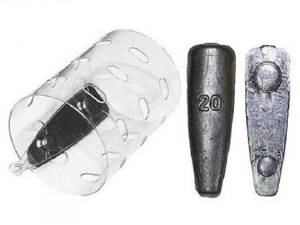
Homemade feeders
What can it be made from?
Many fishermen prefer to make their own feeders; a variety of available materials are suitable for these purposes.
Most often used:
- Metal wire and sheets - these can be purchased at hardware stores.
- Plastic bottles of suitable volume can also serve as the basis for a fishing feeder; additional materials will require flexible wire and a sheet of lead.
- Curlers are another affordable material that allows you to independently determine the shape and color. The structure only needs to be additionally weighted with a small lead plate.
The manufacturing process of some types of feeders
As an example, below are instructions for making a spring-type device with a spiral design:
- Initially, a suitable wire is selected, its cross-section must correspond to the expected fishing conditions; suitable material is brass or copper.
- From 10 to 15 turns of wire are made around the steel rod; to simplify this process, you can use pliers.
- A bar that has completed its task is removed; The spiral design can be manually shaped into a suitable shape.
- When determining the distance between turns, the flow speed and consistency of the bait mixture should be taken into account.
Below is another instruction, using which you can get a closed feeder suitable for fishing in the cold season:
- A film case or any similar plastic container works well as the basis of the design.
- A small weight is placed at the bottom of the container to weigh it down; its weight is selected individually, taking into account the flow speed.
- Holes are drilled in the side parts; the diameter depends on the consistency of the bait mixture.
- All that remains is to attach the device to the fishing line and the fishing feeder is ready.
Varieties of classic feeders
The best feeders for feeders are those selected for specific conditions. We have already discussed the parameters above. Round, square - for everyone. The main thing is that the design is reliable. It is more important to choose the right option directly while fishing in order to comfortably hit the feeding point over and over again. Let's look at different options for feeder feeders based on their design and shape.
Square cells
Conventional square-shaped feeder cages are used on any bottom rigs. They are often supplied with a plastic bottom covering the back. These versatile feeders are made in a variety of sizes and weights. For feeder fishing, the bottom must be removed.
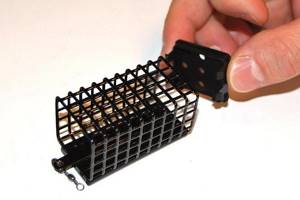
Round
Cormacs with a round cross-section fly better. In the current, contrary to popular belief, they hold up just as well – you just need to choose the weight and shape of the sinker. For fishing in the current, it is better to use feeders with a wide flat bottom, with rounded edges on the inside in the shape of a net cylinder. The current will not be able to turn this form of cormak over. Designs with an oval cross-section hold up even better in the flow. These feeders are flattened from top to bottom. Some manufacturers produce a conical shape, which is wider on the side where it is attached to the equipment. This mesh shape provides good aerodynamics and casting range.
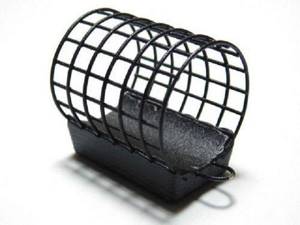
Bullets
For long-distance tempo fishing, it is convenient to use bullet feeders (missiles). Not to be confused with carp feed for boilies and pellets. The bullet feeders on the feeder are loaded with a sinker, shifted to the bow of the structure. The load is located on the axis. Such feeders fly the best, and at long distances, especially in the wind, their use is justified. They can also be used in shallow water to less frighten large fish. When dropped into water, the bullet splashes more quietly than a standard flat-bottom design. An article about bullet feeders for feeders.
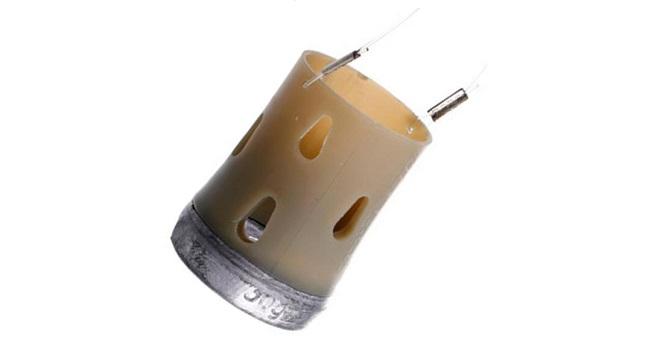
For live bait
Feeder feeders for live food, bloodworms or jigs, closed. They are a closed container with holes through which larvae or crustaceans slowly emerge in the water and settle nearby in uneven bottom topography. Such feeders are indispensable when fish go only for live feeding, often in cold water.

Floating feeder
Floating feeders are used when fishing in still water for carp, grass carp, and silver carp in the water column. In this case, the feeder floats on top, releasing the food stuffed into it downwards. To do this, you can use special store designs that look like large floats with a spring at the bottom, as well as regular feeder feeders by inserting a piece of cork or foam into the mesh. With this equipment you can also catch river fish - roach, sabrefish, blue bream, chub. Floating Feeder is a separate direction of feeder fishing with its own nuances and features. Read more about floating feeder equipment.

Inline feeders
Another large direction of feeder feeders is structures for attaching to the main line using the inline principle, through the entire body along a through channel. Moreover, such sliding feeder feeders can be mounted in both a blind and running version. These are a variety of devices for method feeder fishing - petal models, flat-bottomed flats, banjos and pelet scoops (sticks). A spring feeder for the feeder is also suitable - in the equipment as on a regular donk. However, in feeder fishing it is better to use feed devices specially sharpened for this gear. More details - feeder method feeders.
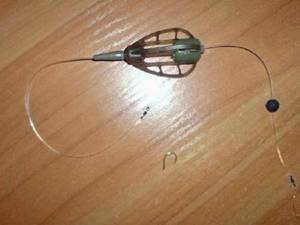
Flat method
Flat feeder feeders are a further development of method designs that work on a similar principle. The feed is stuffed on one side, the other is loaded with a flat sinker. A hook with a nozzle on a short leash is hidden in a lump of bait. After entering the water, the lump is destroyed and the bait is released. Because of this, flat rigs can be used on overgrown reservoirs - the hidden hook will not catch on grass and algae when casting. A flat sinker prevents the rig from sinking into soft mud. The scope of application of flat equipment is fishing in still water for crucian carp, carp, carp and other pond fish. In a strong current, this principle does not work, since the lump of bait will quickly be washed away and carried away to the side. More details – flat feeder feeders.
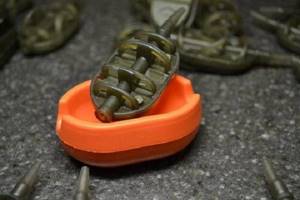
Nipples
On feeder gear, you can use bottom nipples (tops, plugs), crucian carp killers and other bottom rigs. However, with the right approach, it is better to use the methodical method - it is more active and universal. Bottom spring equipment operates on a passive principle when installed for a long time. A nipple or crucian killer can be put on a regular spinning rod - troubles with a feeder rod and thin equipment lose their meaning. With a good bite, both the feeder and the bottom work normally. However, the feeder is more versatile and allows you to successfully catch fish when the bite is bad and the bottoms are silent - due to active work with bait and subtle experiments with equipment.
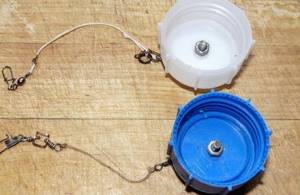
Feeding troughs
Sometimes in feeder fishing it is advisable to use special feeding cages with a large feed capacity and low load. They are needed when you need to quickly deliver a large amount of bait to the point during the starting feeding at the beginning of fishing. This may be required during summer fishing for crucian carp or crucian carp. In strong currents, it is better not to use feeding feeders, since after changing to a working one, the configuration of the equipment will change. Due to other drift by the current, the working equipment may simply not reach the fed point. An article about feeding troughs for feeders.
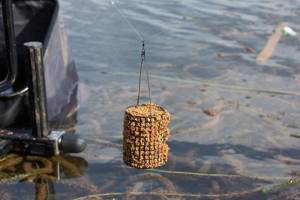
Metal feeder for feeder
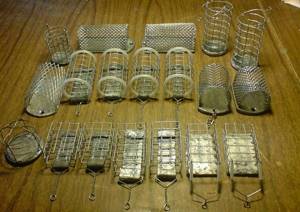
Homemade feeder feeders made of metal mesh are also common in fishing. For the most part, accessories are made of parallelepiped geometry with open or closed ends. To produce such a homemade product, you will need to purchase a metal mesh and preferably a galvanized version with a cell no larger than 5x5 mm. To make a dozen products you will need no more than one square meter of mesh fabric.
Weights, as in the previous version, are used from a set of lead plates as needed for the conditions of the reservoir. From a canvas cut with metal scissors, a shape of the required size is formed by bending the sides of the figure using a mallet. The connection point is soldered with tin or fastened with a wire broach. The lead plate, processed over the area of one of the faces of the figure, is attached through a bolted connection and a spacer washer to the mesh base. A hole is formed on the plate for the fastening ring.
If necessary, the ends are sewn up with a mesh with a smaller cell or a solid sheet of tin. Burrs are ground along the edges of the mesh, preventing all kinds of tangling of the product with the cord, while eliminating its undercuts and deformations. The filed structure is ready for use in strong currents.
DIY feeder feeders
You can make feeders for feeder fishing yourself. The simplest option is to attach the desired weight to the plastic curlers with screws or rivets. The cage can be rolled up from metal - mesh or a solid sheet, followed by drilling holes. The design can be anything - the main thing is to adapt it to the fishing conditions. For successful fishing, you need to comply with the features that are described in detail at the beginning of the article. Read more about homemade feeder feeders.
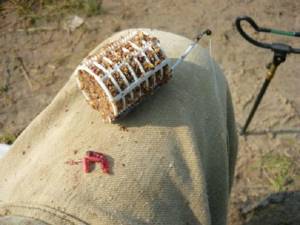
Installation
Feeder fishing is not passive. A set of fishing feeders should be at hand. First you need to select the weight at the beginning of fishing. Often in the process it is also necessary to change equipment, increase or decrease weight and feed capacity. Therefore, a bag for feeder feeders should be at hand, as well as leashes with hooks.
In standard installations, the feed device is attached to the equipment with a noose loop or through a regular carabiner clasp. In the sliding version - a running feeder, a symmetrical or asymmetrical loop, the fishing line is passed into the eye of the swivel or the outlet bead. Anglers make the attachment point to the equipment differently, depending on the installation used and personal preferences. This is not critical - the main thing is that it is simple and reliable, without additional unnecessary elements. Learn more about how to tie a feeder feeder.
